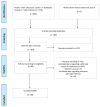Group A Streptococcus Infection in Neonatal Population: A Systematic Review of The Literature
- PMID: 38002589
- PMCID: PMC10672068
- DOI: 10.3390/jcm12226974
Group A Streptococcus Infection in Neonatal Population: A Systematic Review of The Literature
Abstract
(1) Background: The importance of group A streptococcus (GAS) infection severity has been recognized in children and adults. However, to our knowledge, there have been no systematic reviews or pooled assessments of the incidence and outcome of invasive GAS (iGAS) disease in neonates, a potentially high-risk population. Therefore, we performed a systematic review of available data regarding the risk factors, clinical presentation, and outcome of GAS infection in neonates. (2) Methods: An electronic search of the existing literature was carried out during the period July 2023-September 2023 in the PubMed and Scopus databases, considering studies referring to GAS infection in the neonatal population. (3) Results: Overall, 39 studies met all the inclusion criteria and were included in this review, evaluating data from 194 neonates. Unfortunately, there were a lot of missing data among the retrieved studies. Our systematic review highlighted the presence of differences with regards to clinical presentation, infection sites, and outcome of GAS invasive disease between neonates with early-onset (EOS) or late-onset sepsis (LOS). Common characteristics of EOS included respiratory distress, rapid deterioration, and high mortality rate irrespective of the infection site, while rash, gastrointestinal tract symptoms, and fever appeared to be the most frequent symptoms/clinical signs and manifestations of LOS disease. The management of severe invasive iGAS disease consists mainly of specific antimicrobial treatment as well as supportive care with fluids and electrolyte supplementation, minimizing or counteracting the effects of toxins. Furthermore, a mortality rate of approximately 14% was recorded for iGAS disease in the total of all studies' neonates. (4) Conclusions: Although iGAS is a rare entity of neonatal infections, the potential severity of the disease and the rapid deterioration requires the development of quick analysis methods for the detection of GAS allowing the prompt diagnosis and administration of the indicated antibiotic treatment. Furthermore, given the exceptional risk for both the pregnant woman and the neonate, it is very important to raise awareness and create easily accessible guidelines that could facilitate the prevention and management of maternal as well as the subsequent neonatal severe iGAS disease.
Keywords: Streptococcus pyogenes; group A streptococcus infection; invasive infection; neonatal sepsis; perinatal infection.
Conflict of interest statement
The authors declare no conflict of interest.
Figures



Similar articles
-
The future of Cochrane Neonatal.Early Hum Dev. 2020 Nov;150:105191. doi: 10.1016/j.earlhumdev.2020.105191. Epub 2020 Sep 12. Early Hum Dev. 2020. PMID: 33036834
-
State of the Art of Invasive Group A Streptococcus Infection in Children: A Scoping Review of the Literature with a Focus on Predictors of Invasive Infection.Children (Basel). 2023 Aug 29;10(9):1472. doi: 10.3390/children10091472. Children (Basel). 2023. PMID: 37761433 Free PMC article.
-
Group A Streptococcal Infections in Children.Curr Pediatr Rev. 2021;17(1):70-73. doi: 10.2174/1573396316666200704152246. Curr Pediatr Rev. 2021. PMID: 32621721
-
[Clinical characteristics and antimicrobial resistance of invasive group A β-hemolytic streptococcus infection in children].Zhonghua Er Ke Za Zhi. 2014 Jan;52(1):46-50. Zhonghua Er Ke Za Zhi. 2014. PMID: 24680408 Chinese.
-
The prevention of early-onset neonatal group B streptococcal disease.J Obstet Gynaecol Can. 2013 Oct;35(10):939-948. doi: 10.1016/S1701-2163(15)30818-5. J Obstet Gynaecol Can. 2013. PMID: 24165063 Review.
Cited by
-
Group A Streptococcus Infections in Children: Epidemiological Insights Before and After the COVID-19 Pandemic.Pathogens. 2024 Nov 15;13(11):1007. doi: 10.3390/pathogens13111007. Pathogens. 2024. PMID: 39599560 Free PMC article. Review.
-
Neonatal Infectious Disease: A Major Contributor to Infant Mortality Requiring Advances in Point-of-Care Diagnosis.Antibiotics (Basel). 2024 Sep 13;13(9):877. doi: 10.3390/antibiotics13090877. Antibiotics (Basel). 2024. PMID: 39335050 Free PMC article. Review.
-
Streptococcus pyogenes in Neonates and Postpartum Women: First Report on Prevalence, Resistance, emm Typing, and Risk Factors in Khyber Pakhtunkhwa.Pol J Microbiol. 2025 Jun 18;74(2):262-274. doi: 10.33073/pjm-2025-021. eCollection 2025 Jun 1. Pol J Microbiol. 2025. PMID: 40544516 Free PMC article.
-
Group A Streptococcus Bacteraemia Presenting as Acute Limb Ischaemia in a Neonate: A Case Report.Cureus. 2025 Mar 6;17(3):e80170. doi: 10.7759/cureus.80170. eCollection 2025 Mar. Cureus. 2025. PMID: 40190845 Free PMC article.
References
-
- Giannoni E., Agyeman P.K.A., Stocker M., Posfay-Barbe K.M., Heininger U., Spycher B.D., Bernhard-Stirnemann S., Niederer-Loher A., Kahlert C.R., Donas A., et al. Neonatal Sepsis of Early Onset, and Hospital-Acquired and Community-Acquired Late Onset: A Prospective Population-Based Cohort Study. J. Pediatr. 2018;201:106–114. doi: 10.1016/j.jpeds.2018.05.048. - DOI - PubMed
-
- Weston E.J., Pondo T., Lewis M.M., Martell-Cleary P., Morin C., Jewell B., Daily P., Apostol M., Petit S., Farley M., et al. The burden of invasive early-onset neonatal sepsis in the United States, 2005–2008. Pediatr. Infect. Dis. J. 2011;30:937–941. doi: 10.1097/INF.0b013e318223bad2. - DOI - PMC - PubMed
Publication types
LinkOut - more resources
Full Text Sources
Miscellaneous

